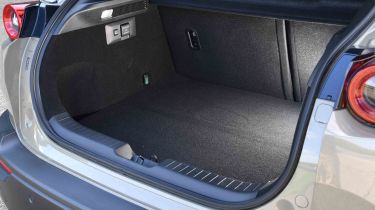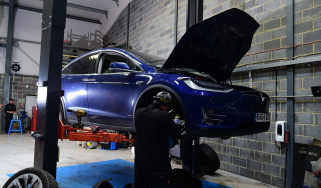Mazda MX-30 - Practicality, comfort & boot space
Compact dimensions aren’t bad, but the door layout restricts accessibility

The MX-30 R-EV isn’t a practical car if you carry a lot of luggage or passengers, despite looking like an SUV. It technically has five doors, but if you treat it as a three-door, you will set your expectations closer to reality.
|
Dimensions | |
|
Length |
4,395mm |
|
Width |
1,795mm |
|
Height |
1,555mm |
|
Number of seats |
Five |
|
Boot space |
332 litres (1,137 litres with seats folded) |
Dimensions and size
The MX-30 falls somewhere between a compact hatchback and an SUV in terms of size. It’s roughly the same length as a Vauxhall Astra, but is narrower and has a taller ride height. The wheelbase and rear overhang also add to the SUV-style proportions, and this has an impact on the interior layout, especially when it comes to rear passenger and boot space.
How practical is the Mazda MX-30?
Seats & space in the front
The MX-30’s front seats are excellent: they offer plenty of support and adjustability, so people of all sizes should be able to get comfortable. Even taller drivers will find loads of room up front and headroom is no issue. There’s a decent amount of storage space, with a useful centre console cubby and a hidden section beneath where you can plug your phone into the USB ports out of sight. There are cup-holders under cork-lined flaps, and a storage bin under the armrest.
Seats & space in the back
Access to the rear is awkward because the doors are hinged at the back and are about half-sized. Plus, you need to open the front door to access them in the first place, in order to reach the handle. Once in the back, there’s not much space for adults. Legroom is poor with the driver’s seat set to a normal position, and headroom isn’t great either, although you should still be able to sit without your head touching the roof. There’s not much foot space either. It’s really only suitable for kids or short trips, rather than something that can be used every day.
Boot space
The MX-30’s boot capacity is 350 litres as standard but gets reduced to 332 litres in higher-spec cars with the Bose stereo, because there’s a subwoofer under the floor. You can fold the seats down to open up 1,137 litres in total, which is decent enough. The boot shape is nice and square but the sloping rear screen means it’s not quite as roomy as it looks if you have a tall item that needs to go in. The charging cables don’t have a dedicated spot and there’s no front boot either, so you’ll need to store them in there as well.








